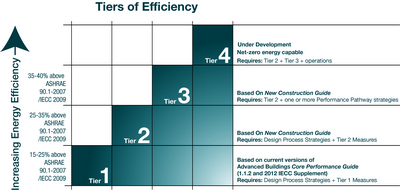Pathway for Advanced Energy Performance in Commercial Projects
By Stacey Hobart
 As the bar rises for meeting base energy codes across the country, finding prescriptive approaches to reach and surpass that bar become more difficult. This scenario is playing out across the country with half the states requiring building standards that meet or exceed ASHRAE 90.1-2010. As a result, construction professionals are tasked with delivering on new practices, which may be unfamiliar, in a manner that fully meets design intentions.
As the bar rises for meeting base energy codes across the country, finding prescriptive approaches to reach and surpass that bar become more difficult. This scenario is playing out across the country with half the states requiring building standards that meet or exceed ASHRAE 90.1-2010. As a result, construction professionals are tasked with delivering on new practices, which may be unfamiliar, in a manner that fully meets design intentions.
To help, the nonprofit New Buildings Institute has developed the Advanced Buildings New Construction Guide, a whole-building, prescriptive guide for small and mid-sized commercial buildings. Based on tens of thousands of building energy simulations, the guide offers pre-assembled, integrated design packages resulting in energy savings over model energy codes. Construction managers can use it as a reference for context on design decisions and intent.
Child and Family of Newport County took advantage of this path to high performance at its 38,700-square-foot office building. The Rhode Island nonprofit is dedicated to strengthening families and communities through services ranging from preschool childcare to workforce development. The project aimed to create a high-performance building that exceeds the state energy code by 30 percent. The building optimizes efficiencies in the heating and cooling systems to achieve 88 percent thermal efficiency; the high-performance envelope features high R-value insulation on the roof and in the walls and enhanced window and skylight performance and controls reduce lighting power density to 0.91 watts per square foot. In all, the efficiency measures produced energy savings of 31 percent over the code base case.
The New Construction Guide was recently adopted by the U.S. Green Building Council as a LEED Pilot Alternative Compliance Path with projects eligible to earn up to 10 energy points in LEED v4. The option for the LEED Optimize Energy Performance credits was submitted and published through USGBC’s Pilot Credit Library, which allows projects to test more innovative credits that have not been through USGBC’s complete drafting and balloting process.
The new designation builds on the guide’s adoption last year by the Northeast Collaborative for High Performance Schools as a prescriptive option to meet the energy performance requirements of Version 3 of the NE-CHPS Criteria. CHPS maintains the leading authoritative criteria on energy-efficient, cost-effective design and construction practices for schools. The guide has also been endorsed by Architecture 2030 as a prescriptive path to meet the 2030 Challenge target working for carbon neutrality in all new construction, development and major renovations by 2030.
Progressively stringent tiers allow the New Construction Guide to deliver savings in a national landscape (where states and local jurisdictions have energy codes with drastically different levels of stringency) while also providing greater levels of energy efficiency to projects seeking higher performance. Tiers 1 through 3 predict efficiencies from 15-40 percent above ASHRAE 90.1-2007. The fourth tier, which is under development, will represent approaches to achieve zero net energy performance.
For USGBC credits, two possible options for using the New Construction Guide to receive Optimize Energy Performance credits in LEED v4 include: 1) achieving up to six points by complying with the requirements of Section Two: Tier 2 of the guide, and 2) achieving up to 10 points by complying with the requirements of Section Three: Tier 3.
For decades, building energy codes remained largely stagnant. But today, the willingness of building owners and developers to strive for higher levels of energy performance is spurring codes to advance more quickly. Heavily prescriptive approaches must make way to innovative and flexible thinking if the construction professionals must deliver on these projects, are to meet the rising bar of efficiency stringency.
Photo caption: The Advanced Buildings New Construction Guide recommends packages of efficiency measures that result in energy savings ranging from 15-40 percent above conventional practices.
Stacey Hobart works in marketing and communications with New Buildings Institute. For info, visit newbuildings.org.


 Join our thriving community of 70,000+ superintendents and trade professionals on LinkedIn!
Join our thriving community of 70,000+ superintendents and trade professionals on LinkedIn! Search our job board for your next opportunity, or post an opening within your company.
Search our job board for your next opportunity, or post an opening within your company. Subscribe to our monthly
Construction Superintendent eNewsletter and stay current.
Subscribe to our monthly
Construction Superintendent eNewsletter and stay current.